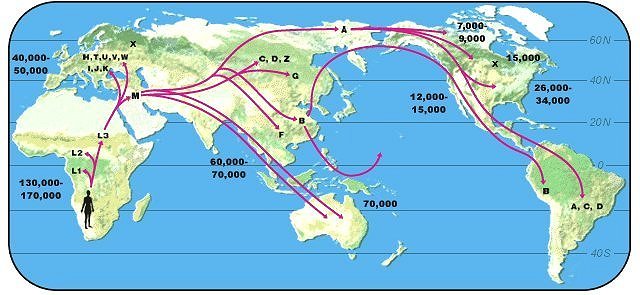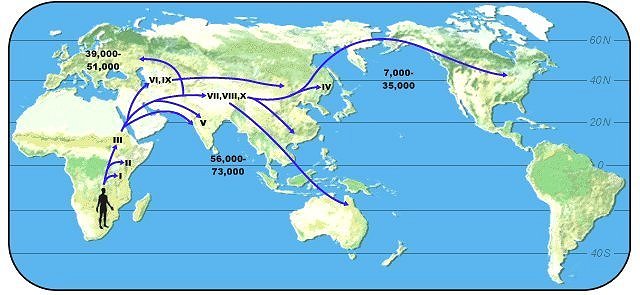POPULATION GENETICS
Mitochondrial DNA and Y-chromosomes are genetic markers inherited directly from one's mother and father, respectively. Being non-adaptable and non-recombining with very slow mutation rates renders them useful in detecting ancestry and tracing population movements. However, autosomes, which use multiple ancestry informative markers to paint a more complete picture, are beginning to gain ground and are thought by many to be superior to single locus analyses. Note that markers used in the field's infancy, like restriction enzymes, HLA genes, sickle cell and other blood groups, have now been recognized as unreliable.
Mitochondrial DNAmtDNA, inherited maternally, consists of European haplogroups H, I, J, K, T, U, V, W and X; Asian haplogroups A, B, C, D, F, G, M and Z; and African haplogroups L1, L2 and L3. Asian- and African-specific lineages exist at very low frequencies throughout Europe.
* * *

Y-chromosomesY-chromosomes, inherited paternally, are made up of African Groups I, II and III and Asian Groups IV-X; European lineages are all variations of these Groups. In the more common Jobling/Tyler-Smith nomenclature, we have prominent European haplogroups 1, 2, 3, 9, 21, 22 and 25; Asian haplogroups 4, 10, 12, 16 and 28; and African haplogroups 6, 7 and 8. African-specific lineages are virtually absent in Europe, while Asian-specific ones are concentrated in the Northeast.
* * *

Autosomes" 'Genes on the mitochondrial genome or the Y chromosome don't unambiguously allow you to infer population history,' notes Andrew G. Clark, a biology professor at Pennsylvania State University. 'That's because there's a lot of stochasticity, a lot of chance, that goes on in sampling of those genomes from generation to generation. What the autosomal genes get us is many more realizations of genes passing through history. If we look at enough of them we'll be able to get a good call on the true population history.' Especially ripe for examination, Clark adds, are autosomal regions with low rates of recombination, which are just now being identified. ...more autosomal studies are crucial for advancing the field of molecular anthropology: The 22 autosomes, after all, harbor the lion's share of polymorphisms."
* * *
"Earlier we emphasized the importance of using a large number of loci in the study of human evolution. This is because (a) the interpopulational genetic variation is very small compared with intrapopulational variation and (b) the evolution of a single gene (or mtDNA) is subject to large stochastic errors (Nei and Livshits 1989; Livshits and Nei 1990). In this study, using gene frequency data for 29 genetic loci, we could reconstruct an evolutionary history of human populations that seems likely to be less controversial and more enduring than some current alternatives."
Related Topics
The Seven Daughters of Eve: Brian Sykes' delineation of European mtDNAs and their origins.
Y-chromosome Tree: Large table of the different systems of Y-chromosome nomenclature.
Introduction to mtDNA and Y-chromosomes: More detailed information on different haplogroups.
Tat-C: Y-chromosome lineage of Asian origin which has spread to NE Europe.
European Genetic Variation: Cavalli-Sforza's autosomal DNA analysis of European populations.
Blood Groups: Not reliable tracers of ancestry.
